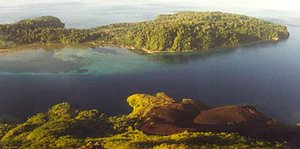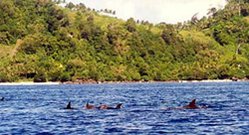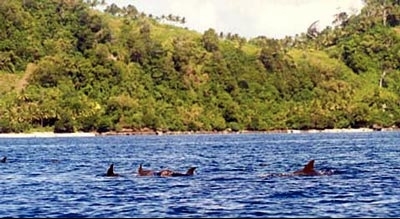Banda Sea Islands moist deciduous forests
Introduction The Banda Sea Islands Moist Deciduous Forests are found on small islands scattered across the Banda Sea and are part of the region (Banda Sea Islands moist deciduous forests) known as Wallacea, which contains a distinctive fauna representing a mix of Asian and Australasian species. Active volcanoes are found on the Banda Islands, whereas other parts of the ecoregion represent portions of the Australian continent that have been torn off. The islands contain a remarkable twenty-one bird species found nowhere else on Earth. The forests in this ecoregion are still largely intact, but although many of these islands are tiny and uninhabitable, the bird populations are seriously threatened by accidentally released rats and cats and by the removal of their eggs for sale by fishers traveling through this area.
Location and General Description
 Banda Islands, Indonesia. (Source: Anasia-Cruise)
Banda Islands, Indonesia. (Source: Anasia-Cruise)
This ecoregion represents the moist deciduous and limestone forests of Tanimbar, Kai, Banda, and smaller island groups in the Banda Sea, part of the eastern Indonesian Archipelago. Based on the Köppen climate zone system, this ecoregion falls in the tropical wet climate zone. Geologically, the islands have a mixed history. The Banda Islands are part of the inner arc, whereas the rest of the ecoregion is part of the outer arc. The inner arc islands are a result of the subduction and partial melting of the Indo-Australian tectonic plate below the Eurasian plate. The inner arc islands represent young volcanoes that have coalesced with lava and sediment. The volcanically active Mount Api is found in the Banda Islands, which represent the ruins of a very large volcano that erupted in prehistory. The basement rock of the outer islands, on the other hand, is composed of actual continental margin from the Australian plate that has not been subducted. These outer islands are less than 4 million years old. The resulting surface geology consists of complex sedimentary and metamorphic rocks: uplifted coral reefs over complex basement rocks.
In the south the forest biogeography of the Moluccas differs from that associated with the classic dipterocarp forests of Borneo or Sumatra. Northern Maluku has relatively similar dipterocarp forests. Many of the dipterocarp species have been replaced by dominants more typical of the Australo-Melanesian area. The forests of this ecoregion are varied but include evergreen rain forest (Kepulauan Kai), semi-evergreen rain forest, [[moist deciduous] forest], and dry deciduous forest.
Biodiversity Features
 Banda Islands, Indonesia. (Source: Anasia-Cruise)
Banda Islands, Indonesia. (Source: Anasia-Cruise) The mammal fauna consists of twenty-two species with both Asian and Australasian affinities, and three species are endemic (Table 1). The Moluccan mouse-eared bat (Myotis stalkeri) is endangered, whereas the dusky pademelon (Thylogale bruinii), and brown-bearded sheathtail bat (Taphozous achates) are considered vulnerable. The dusky pademelon is the only macropodid (kangaroo) found in the Banda Sea islands (Kai), although it is also found in the Aru Islands and the Trans Fly of New Guinea.
Together with Halmahera, Buru, and Seram islands, this ecoregion lies within an area with perhaps the highest levels of bird endemism for its size anywhere in the world and the highest number of endemic birds of any area in Asia. Even the smallest, uninhabitable islands are significant as breeding sites for large numbers of seabirds such as frigatebirds, tropicbirds, boobies, terns, and smaller species. Manuk Island and Mount Api (north of Wetar), two nature reserves in the Banda Sea, are the breeding and roosting sites for millions of seabirds. Active volcanoes, they are probably the greatest bird islands left in all southeast Asia. This ecoregion contains more than 225 species of terrestrial birds, of which forty-three are endemic or near endemic (Table 2). This ecoregion corresponds with the Banda Sea Islands Endemic Bird Area (EBA), which contains forty-one restricted-range species, and includes eighteen species that are found nowhere else on Earth. Only one of these species, the Damar flycatcher (Ficedula henrici), is considered threatened.
|
Table 1. Endemic and Near-Endemic Mammal Species. Family Species Macropodidae Thylogale bruinii Vespertilionidae Myotis stalkeri* Emballonuridae Taphozous achates* An asterisk signifies that the species' range is limited to this ecoregion. Table 2. Endemic and Near-Endemic Bird Species. Family Common Name Species Megapodiidae Tenimbar megapode Megapodius tenimberensis* Megapodiidae Forsten's scrubfowl Megapodius forstenii Columbidae Dusky cuckoo-dove Macropygia magna Columbidae Wallace's fruit-dove Ptilinopus wallacii Columbidae Pink-headed imperial-pigeon Ducula rosacea Cacatuidae Tanimbar cockatoo Cacatua goffini* Loriidae Red lory Eos bornea Loriidae Blue-streaked lory Eos reticulata* Loriidae Olive-headed lorikeet Trichoglossus euteles Cuculidae Green-cheeked bronze-cuckoo Chrysococcyx rufomerus* Cuculidae Pied bronze-cuckoo Chrysococcyx crassirostris Cuculidae Kai coucal Centropus spilopterus* Strigidae Moluccan hawk-owl Ninox squamipila Tytonidae Lesser masked-owl Tyto sororcula Alcedinidae Cinnamon-backed kingfisher Todirhamphus australasia Acanthizidae Rufous-sided gerygone Gerygone dorsalis Meliphagidae White-tufted honeyeater Lichmera squamata Meliphagidae Banda myzomela Myzomela boiei* Meliphagidae Black-faced friarbird Philemon moluccensis Eopsaltriidae Golden-bellied flyrobin Microeca hemixantha* Pachycephalida Drab whistler Pachycephala griseonota Pachycephalida Wallacean whistler Pachycephala arctitorquis* Rhipiduridae Cinnamon-tailed fantail Rhipidura fuscorufa* Rhipiduridae Long-tailed fantail Rhipidura opistherythra* Monarchidae White-naped monarch Monarcha pileatus Monarchidae Black-bibbed monarch Monarcha mundus* Monarchidae White-tailed monarch Monarcha leucurus* Monarchidae Moluccan flycatcher Myiagra galeata Oriolidae Buru oriole Oriolus bouroensis Campephagidae Kai cuckoo-shrike Coracina dispar* Turdidae Slaty-backed thrush Zoothera schistacea* Turdidae Orange-banded thrush Zoothera peronii Turdidae Fawn-breasted thrush Zoothera machiki* Sturnidae Tanimbar starling Aplonis crassa* Muscicapidae Cinnamon-chested flycatcher Ficedula buruensis Muscicapidae Damar flycatcher Ficedula henrici* Zosteropidae Great Kai white-eye Zosterops grayi* Zosteropidae Little Kai white-eye Zosterops uropygialis* Sylviidae Timor stubtail Urosphena subulata Sylviidae Tanimbar bush-warbler Cettia carolinae* Estrildidae Tricolored parrotfinch Erythrura tricolor Dicaeidae Ashy flowerpecker Dicaeum vulneratum Dicaeidae Red-chested flowerpecker Dicaeum maugei An asterisk signifies that the species' range is limited to this ecoregion. (Banda Sea Islands moist deciduous forests) ==Current Status== This ecoregion consists of a chain of small islands. The forests in this ecoregion are still largely intact, with only about 20 percent of the habitat being lost. The island of Yamdena in the Tanimbars represents a fairly large block of undisturbed habitat. There are five protected areas that cover 1,500 kilometers2 (27 percent) of the ecoregion (Table 3). However, the largest of the protected areas is still in a proposed state. {| width="640" border="1" cellpadding="1" align="center" ! colspan="3" align="center" | Table 3. WCMC (1997) Protected Areas That Overlap with the Ecoregion. Protected Area Area (km2) IUCN Category Kai Besar 290 PRO Pulau Nuswotar 40-75 I Jamdena 1,130 PRO Pulau Nustaram 30 I Pulau Lucipara 20 ? Pulau Angwarmase 10 I Gunung Api (north of Wetar) 1 ? Total 1,521 Ecoregion numbers of protected areas that overlap with additional ecoregions are listed in brackets. (Banda Sea Islands moist deciduous forests) ==Types and Severity of Threats== Although many of these islands are tiny and uninhabitable, the bird populations are seriously threatened by predatory rats and cats that have been accidentally released onto these islands and by the removal of their eggs for sale by fishers traveling through this area. On inhabited islands, such as Manuk Island Nature Reserve, small-scale agriculture poses another threat as farmers oust both tree-nesting and ground-nesting birds. ==Justification of Ecoregion Delineation== The Sula Islands were included within the Sulawesi Lowland Rain Forests and the Aru Islands in the Vogelkop-Aru Lowland Rain Forests. Buru Island, identified as a distinct subunit by MacKinnon and as an Endemic Bird Area (EBA), was delineated as a distinct ecoregion, the Buru Rain Forests. Seram, the larger island to the east of Buru, was also delineated as an ecoregion: Seram Rain Forests. The larger Halmahera Rain Forests includes Obi Island, which MacKinnon recognized as a separate subunit from Halmahera Island. We created the Banda Sea Islands Moist Deciduous Forests by combining the islands in the Kai and Tanimbar archipelagos, which were distinguished as a biogeographic unit by Monk et al. The primary vegetation on the islands in both these archipelagos is [[moist deciduous] forests] and semi-evergreen forests, whereas the vegetation in the other, nearby large islands (Seram and Aru) is [[evergreen rain forest]s (Biome)]. ==Additional Information on this Ecoregion== * For a shorter summary of this entry, see the WWF WildWorld profile of this ecoregion. * To see the species that live in this ecoregion, including images and threat levels, see the WWF Wildfinder description of this ecoregion. * World Wildlife Fund Homepage |}
|
|---|

